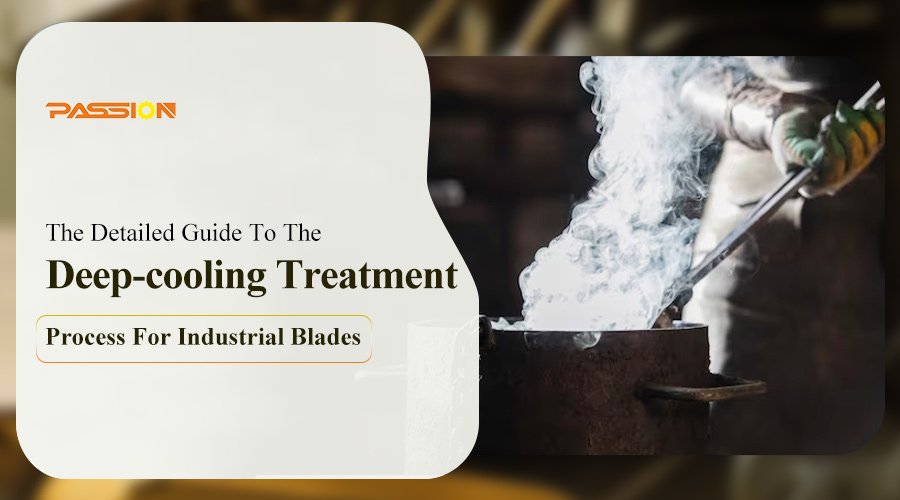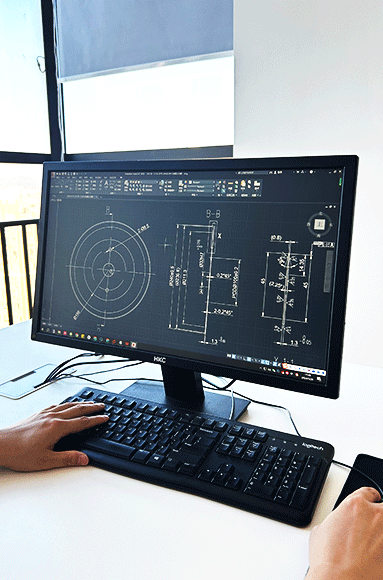Deep-cooling treatment process is a process of placing materials or parts at a low temperature of -130 to -190°C and treating them according to a certain process. It can not only treat ferrous metals, non-ferrous metals, metal alloys and carbides, but also non-metallic materials. Deep-cooling treatment is an effective process means for cutting blade materials.
Principle of cryogenic treatment
When the steel contains more carbon and alloying elements (AI, Co except) martensite transformation termination point will drop to 0 ℃ below low temperature, after quenching the organisation contains a larger number of residual austenite. In order to make the residual austenite transformation to martensite, the quenched workpiece can be placed in the chiller or refrigerator to continue cooling, which is the principle of low temperature treatment.
Purpose Of Deep Cold Treatment
Deep-cooling treatments, especially deep-cooling treatments, can cause changes in the microstructure of the insert material by subjecting the blade to extremely low temperatures (e.g. -130°C to -190°C), thereby improving its overall performance. The main objectives include:
To promote the transformation of residual austenite to martensite and to increase hardness
The unique and major advantage of cryogenic freezing is that it causes the metal atoms to rearrange themselves, thereby increasing the martensitic structure of the metal and decreasing its austenitic structure. Martensite is a hard crystalline structure, whereas the austenitic structure provides more flexibility and ductility, which means it is able to bend under tensile stress without breaking.
Refinement of grain size improves the strength and toughness of the material
Cryogenic freezing results in a more uniform distribution of atoms in the metal itself, a process that helps to eliminate micropores and other defects in the metal, allowing the material gap closures to become denser and the grain structure to become more uniform, changes that help to improve the strength and toughness of the material.
Reduces the likelihood of internal stresses and cracks developing
During manufacturing, residual stresses may develop inside the blade as a result of machining, heat treatment (e.g., hardening) or other process steps. These stresses, if not relieved, may cause the blade to deform, crack or fail prematurely during use. Deep-cooling helps to relax these residual stresses, resulting in a more stable blade.
Enhanced fatigue strength
After ultra-deep cooling treatment of steel cutting blades, their flexural strength, impact toughness and red hardness will be significantly improved. The enhancement of these properties directly reflects the enhanced fatigue strength of the blade.
Improved oxidation resistance
Deep-cooling is a process that does not promote oxidation of the metal surface, which means it will not discolour, cause wear due to oxidation and extend the life of the metal. Conversely, certain heat treatments may cause oxidation of the metal surface, which can increase wear.
Providing a permanent hardening treatment
Deep cold treating tools and blades is a one-time procedure performed on metal products during manufacturing or repair. Since the process alters the material on an atomic level, the properties of the metal have been permanently altered. Once deep-cooled, the metal does not lose its enhanced durability, wear resistance and stress-relief capabilities, and all the benefits of cryogenic freezing are permanently retained on the blade unless it is subsequently subjected to a deliberate tempering process.
Reduced Safety Risks
The use of dull blades requires more force and increases the risk of the blade catching the material, stopping in the middle of the cut, or even kicking the material back if a clean cut cannot be made. Deep-cooling of industrial knives can circumvent these risks to some extent by maintaining the sharpness of the blade for longer.
Improved dimensional stability
Deep-cooling also reduces dimensional changes in the material due to temperature changes, which is an important advantage for blades that require high precision and stability.
Reduced sensitivity to pressure
In industrial environments, inserts are often subjected to repetitive use under high pressure conditions. One of the main reasons blades cannot withstand repeated, high-stress use and cause fracture is the lack of homogeneity of the metal composition at the molecular level. When metal is heated and then rapidly plunged into deep cryogenic conditions, it promotes a more homogeneous composition of the final product.
Comparison of effect after deep cold treatment
The comparison of the effect of carbide blade after deep-cooling treatment is shown in the attached table. Experimental conditions: the cutting specimen is grey cast iron (HT250), the blade material is carbide. Cutting parameters are the same before and after deep-cooling treatment.
Comparison table of blade life before and after deep-cooling treatment of cemented carbide knives
| No. | Name | Processing content | Specification | No. of experiments | Original service life (pieces/times) | Service life after treatment (pieces/times) | 1 | Milling cutter | Keyseat milling | f7.5-2NT | 1st | 400 | 3435 |
|---|---|---|---|---|---|---|
| 2 | Milling cutter | Keyseat milling | f7.5-2NT | 2nd | 400 | 3306 |
| 3 | Milling cutter | Keyseat milling | f7.5-2NT | 3rd | 400 | 3325 |
| 4 | Milling cutter | Milling orifice | f11.5、32-2NT | 1st | 150 | 300 |
| 5 | Milling cutter | Milling orifice | f11.5、32-2NT | 2nd | 150 | 290 |
| 6 | Milling cutter | Milling stomatal surface | f12、48-2NT | 1st | 200 | 300 |
| 7 | Milling cutter | Milling stomatal surface | f12、48-2NT | 2nd | 200 | 315 |
| 8 | Milling cutter | Milling Air Hole End | f13、48-2NT | 1st | 250 | 385 |
| 9 | Milling cutter | Milling Air Hole End | f13、48-2NT | 2nd | 250 | 406 |
After deep-cooling treatment, the material stability is improved, the harmful stress is reduced, and the blade life is improved. Through the grey cast iron parts processing test confirmed that the same cutting parameters processing the same parts, as can be seen from the attached table, after deep-cooling treatment of the average life of the blade significantly increased by about 1.53 ~ 8.4 times or so.
Tests also found the following problem: if the blade for deep-cooling treatment, not in -200 ℃ for 4 ~ 5h insulation, but the blade will be placed in the room temperature for about half a month, the life of the blade becomes the same as without deep-cooling treatment. Secondly, the blade can not be put directly into the liquid nitrogen, which will make the blade was “thermal shock” damage. In addition, if the original heat treatment is not reasonable, the effect of deep-cooling treatment will also be very little. It is not possible to turn a poor quality alloy into a good quality alloy by deep-cooling.
Processing Flow
The deep-cooling treatment process generally consists of the following steps:
Heat treatment
Firstly, the blade is heated to the specified temperature and quenched to form a certain amount of residual austenite and residual stress.
Deep cooling treatment
Cooling down: The blade is rapidly cooled to the deep-cooling temperature range (e.g. -130°C to -190°C).
Holding: Keep the blade at low temperature for a certain period of time (e.g. 24 hours or more) to ensure that sufficient transformation occurs within the material.
Warming: Slowly warm to room temperature to avoid thermal shock and dimensional changes.
Tempering or aging treatment
In order to eliminate residual stresses generated during deep cooling treatment and to stabilise the newly generated martensitic organisation, tempering or aging treatment is usually required.
Processing equipment
Deep-cooling treatment chambers
Deep-cooling treatment chambers with computerised continuous monitoring and automatic adjustment can ensure precise temperature control during the treatment process.
Refrigeration system
liquid nitrogen or other low-temperature medium is usually used as refrigerant to ensure that the temperature inside the treatment chamber reaches the required level.
Caveat
Treatment time
The time for deep-cooling treatment should be set according to the material and specific requirements of the insert; too long or too short a time may affect the treatment results.
Temperature control
Precise control of the temperature during the treatment process is essential to avoid degradation of material properties due to overheating or overcooling.
Tempering
Tempering is a necessary step after deep cooling treatment and must be carried out in strict accordance with the process requirements.
Safety Measures
Safety operating procedures should be strictly adhered to during the treatment process to ensure the safety of personnel and equipment.
Industrial blade deep-cooling treatment is an important process technology, through precise control of the temperature and time and other parameters in the treatment process, it can significantly improve the overall performance and service life of the blade, reduce the number of times of blade change and sharpening, and reduce production costs. In practical application, according to the material of the blade and the specific requirements of a reasonable deep-cooling treatment design, and strictly comply with the process procedures and safety regulations.



